Best Orthotics for Kids with In-Toeing – Let’s Improve Your Child’s Posture by Preventing the Feet from Collapsing!
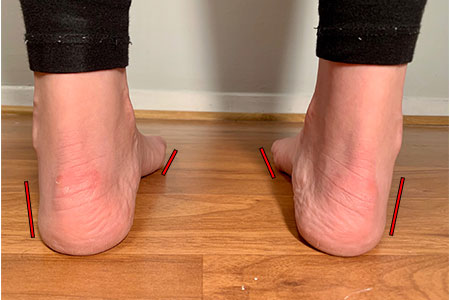
Do you have a child who has been diagnosed with in-toeing? Have you tried a pair of supportive shoes but your child’s feet still point inwards instead of pointing straight? I have put together a selection of the best orthotics for kids with in-toeing based on my 10 years of experience fitting children’s shoes and orthotics.
In-toeing is also referred to as “pigeon toes”, and it’s a condition that can cause your child to trip more often or move more awkwardly. One of the biggest issues with having in-toeing in growing children is that it creates a foot imbalance and the normal development of your child’s pelvis and the spine will suffer.
At the shoe store where I work, there are a lot of physical and occupational therapists who refer families to the store to be fitted for supportive shoes and orthotics. The store specializes in fitting shoes and orthotics for children with foot and leg problems.
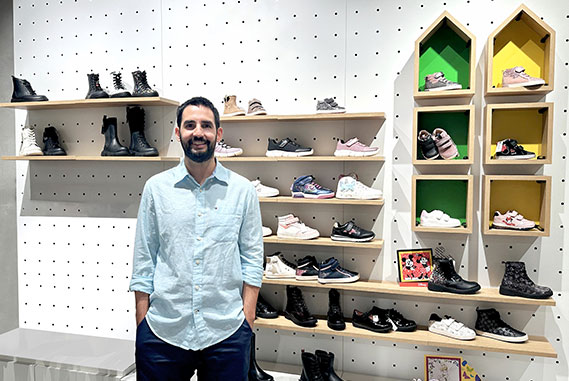
I get contacted by families from all over the world who are told by their medical professionals that their child will eventually outgrow the condition, but these families are still concerned since their child’s walking gait is clearly abnormal.
Don’t Leave Your Child’s Foot Condition Untreated – Be Proactive!
I suggest being proactive and don’t take the “wait and see approach” when it comes to treating your child’s in-toeing condition. Waiting for the condition to get corrected on its own might actually lead to the condition getting worse.
In-toeing is one of the most common pediatric gait disturbances, but if you leave your child’s in-toeing condition untreated, your child might develop several complications that include:
- An unbalanced gait
- Reduced athletic ability
- Foot deformities such as bunions, hammertoes, and flat feet
- Foot, leg, hip, and lower back pain
The good news is that if you fit your child in the correct type of orthotics and supportive shoes, you might be able to prevent all of those complications.
Is Your Child Already Wearing a Pair of Supportive Shoes?
If you have already tried a pair of supportive shoes but they were not effective in treating and preventing your child’s in-toeing condition, the next step is to try a pair of orthotics.
Can Orthotics Help Treat and Correct In-Toeing?
Orthotics help correct biomechanical foot issues such as problems with how your child walks, stands, or runs by providing additional support and a solid foundation to your child’s feet and legs. However, not all orthotics provide the same level of effectiveness when it comes to treating a child’s foot condition. After trying several different types of orthotics for children with in-toeing, I found two to be the most effective ones in helping realign the child’s feet and legs, and I will show you these orthotics shortly.
One of the orthotics that I recommend works best for children who have mild cases of in-toeing, while the other one works best for children with moderate to severe cases of in-toeing.
What Makes the Orthotics that I Recommend Effective for In-Toeing?
1️⃣ Targeted arch support helps control foot pronation (inward rolling of the foot):


2️⃣ Deep heel cups help provide overall foot support and control heel and lower leg alignment:
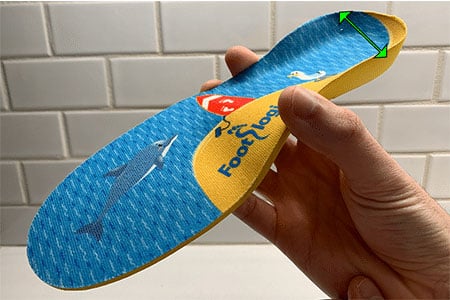
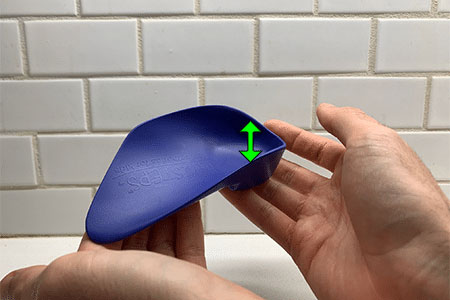
I have helped improve the walking gait and posture of hundreds of children who were in-toeing by providing them with a pair of everyday supportive sneakers and orthotics. Please keep in mind that the shoes and the orthotics work together when it comes to treating your child’s in-toeing. This means that if you provide your child with a pair of the orthotics that I recommend but the shoes are not supportive enough, your child won’t be able to get the full benefits that the orthotics have to offer, and vice versa.
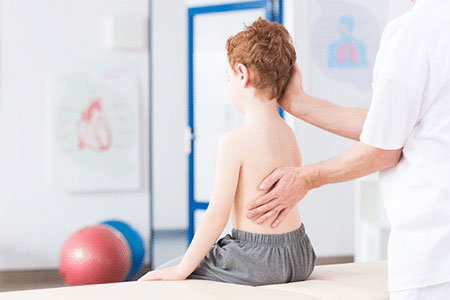
Orthotics that Help Treat and Prevent In-Toeing – Here’s the Proof!
Something so simple such as providing your child with the correct type of shoes and orthotics can help correct your child’s walking gait and allow your child to walk and run straighter. The correct type of orthotics can also help improve your child’s overall posture. Let me prove this to you.
Let’s take a look at an image of a flat-footed child barefoot who is experiencing in-toeing issues. Do you notice how the child’s feet are collapsing and turning inwards? The feet are shifting the child’s whole body out of alignment.

Before Image of a Child Standing in a Pair of Unsupportive Orthotics
Let’s take a look at an image of the same child standing in a pair of supportive insoles/orthotics. Do you notice how the child’s feet are still collapsing and turning inwards?
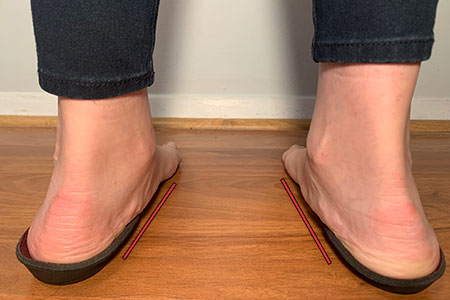
After Image of the Same Child Standing in a Pair of Supportive Orthotics
Now, let’s observe what happens when we stand the same child in a pair of the orthotics that I recommend. Do you notice how the child’s feet look a lot straighter? The orthotic is preventing the child’s feet from collapsing and turning inwards.
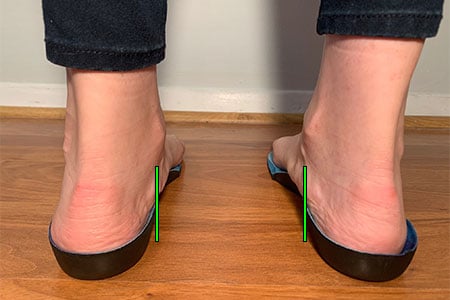
If you had both of these orthotics in your hands you will notice how these two orthotics look very similar, but they actually provide very different levels of support.
The final picture shows the same child wearing a pair of supportive shoes with the orthotics that I recommend inside. Do you notice how straight the child’s feet and legs are?
After Image of the Same Chid Standing in a Pair of Supportive Orthotics and Shoes
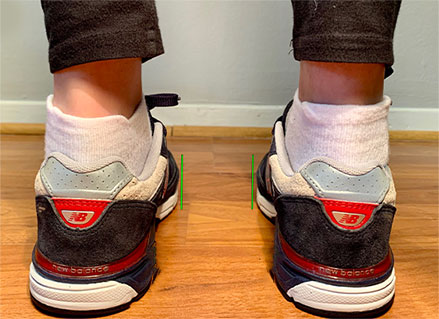
Now that you know what features this orthotic provides you are ready to take a look at the best orthotics for kids with in-toeing. Keep in mind that I only review shoes and orthotics that I have fitted before since that is the only way for me to tell how much support the orthotics and shoes provide as well as how they fit.
Orthotics for Kids with In-Toeing – Read This Before Deciding Between the Two
There are two orthotics that I recommend for in-toeing, and the one that will work best for your child directly depends on the degree of your child’s in-toeing. For example, in-toeing can be categorized in 3 different cases:
- Mild: You notice that your child’s feet turn inward slightly instead of pointing straight ahead, but your child does not complain about any pain.
- Moderate: You notice that your child’s feet turn inwards instead of pointing straight ahead, and your child complains about foot or leg pain. Children with moderate in-toeing have poor walking habits as their feet turn inwards at a considerable level.
- Strong: You notice that your child’s feet turn inwards considerably and your child complains about foot or leg pain. Children with strong in-toeing show clear signs of poor walking habits.
Best Orthotics for Kids with MILD Cases of In-Toeing
- Fits a toddler shoe size 5 up to a big kid shoe size 3
- Medically approved insoles with targeted cushion and support
- Deep heel cup with strong arch support
- Made from lightweight yet supportive cushioning material with shock-absorbing heel padding
- Forefoot padding to increase comfort
- They can be trimmed to size with scissors if needed
Do You Need to Remove the Original Insoles of Your Kids’ Shoes?
Yes, I suggest that you remove the original insoles of your child’s shoes before placing this orthotic inside the shoes.
Best Orthotics for Kids with MODERATE or SRONG Cases of In-Toeing
1️⃣ Deep Heel Cups provide foot support and helps to control heel and lower leg alignment
2️⃣ Medial Rearfoot Posting helps control foot pronation (inward rolling of the foot)
You Must Enter a Referral Code to Order this Orthotic
To place an order for littleSTEPS® Orthotics, you must submit a Referral Code during the ordering process in the Discount Window: JVFCS100121
Do You Need to Remove the Original Insoles of Your Kids’ Shoes?
No, you won’t have to remove the original insoles of your child’s shoes before placing this orthotic inside the shoes.
Take a look at the chart below to figure out what size to order based on your child’s shoe size:

Are You Unsure About What Orthotic Will Work Best for Your Child’s Feet?
Don’t hesitate to contact me if you are unsure about which orthotics will work best for your child’s in-toeing:
What Are the Best Sneakers for Kids Who Wear Orthotics?
Please remember that for your child to get the full benefits that the orthotics have to offer, you must fit them in the correct pair of shoes.
You will notice how those shoes all come with shoelaces instead of velcro closure since shoelaces provide your child with better support and stability. Children who have in-toeing have a lot of stability issues, meaning that your child will benefit a lot from wearing shoes with shoelaces. Another benefit of providing your child with shoes that come with shoelaces is that it helps keep the orthotic in place.
Before you leave, there is an article that you might find helpful since it will teach you how to tie shoes for kids who wear orthotics.
Some occupational therapists might recommend casts, orthopedic shoes, and even surgery to help treat and correct in-toeing. These 3 approaches might not always be effective, and providing your child with the correct type of shoes and orthotics is a less invasive alternative that will help treat and prevent your child’s in-toeing.
Certain families have reported how casts and surgery were ineffective treatment methods for in-toeing, and reported how certain orthotics have proven to be effective in improving their child’s walking gait pattern and posture.
Have you found a particular shoe style or orthotic that has been effective in treating and preventing your child’s in-toeing condition? Please share your thoughts below so other families can benefit from your experiences.




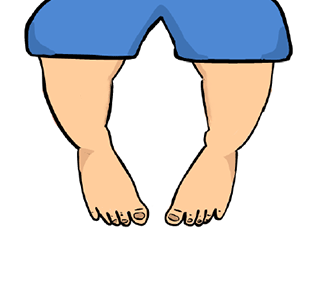

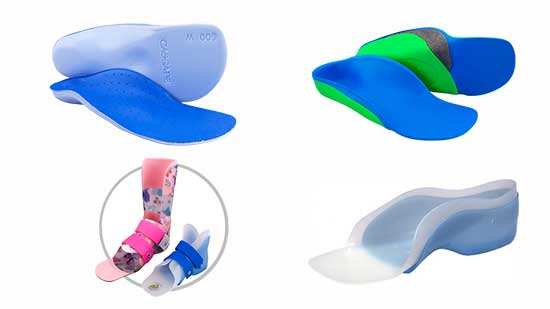
PLEASE, my 16 mo. old has pretty bad bow-legging & in-toeing (esp. the left foot) & NO shoes will stay on him for long without his heals working their way out. Not to mention how often he trips & stumbles. Due to the weird slope of his heels its hard to even get them into a shoe to begin with. Problem is there are no children’s shoe stores where we live. Where do I take him? The pediatrician?
Hello Meg —
As far as getting your son fitted for orthotics or another treatment I suggest consulting your medical professional.You can start with your pediatrician or physical therapist.
As far as shoes concern, is your son wearing shoes with shoelaces or velcro closure? Are you sure the shoes were not fitted too big? There is a specific shoe lacing technique that helps keep the shoes in place and prevent them from slipping out the child’s feet.
Start by taking a look at this article: How to Measure Your Kids’ Foot – 2 Simple Steps to Determine Foot Length and Foot Width that way I can get a better idea of your son’s foot shape and we can check wether your son is wearing shoes in the correct length and width.
In that email please include what type of shoe your son is currently wearing.
I’m having this same issue. Has your son conditions improved through the shoes? Mine is turning 17months and has bowed leg and intoeing. Chiropractor has helped his hip and some of the issues but his intoeing continues to cause bowing of his leg and he falls and trips every 5min.